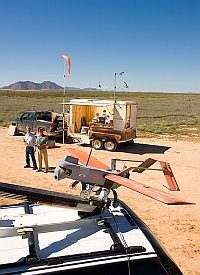A scientist with the U.S. Department of Agriculture and a technical consultant from industry have developed and patented a technology that converts digital cameras to color infrared cameras for aerial photography. Raymond Hunt, with USDA’s Agricultural Research Service in Beltsville, Maryland and David Linden, chief scientist at Science Applications International Corporation (SAIC) in McLean, Virginia described their invention last year in the journal Remote Sensing.
In July 2011, Hunt and colleagues from USDA and University of Idaho published an application of the technology involving measurement of chlorophyll content of vegetation in Agronomy Journal (paid subscription required).
Hunt and Linden’s method allows photographing with light in the near-infared (NIR), green and blue bands, which are used to measure the “greenness” of vegetation and extent of crop canopy cover. To develop the technology, they started with a commercially-available 12-megapixel digital camera without an internal filter that blocks NIR light. They then added a custom-made lens filter to block red light and transmit NIR.
The images that result from the technology, for which Hunt and Linden have been granted a patent, need no further processing, so the images can be examined immediately upon retrieval. The compact design and lighter weight of the cameras make them easier to fit on small Unmanned Aerial Vehicles (UAVs) that can fly as low as a few hundred feet. (UAVs are not yet approved by the FAA for commercial use.)
Hunt and colleagues at Beltsville have used aerial photographs from the cameras useful for detecting the extent of farmland in the Chesapeake Bay watershed that is protected from soil erosion by winter wheat and other winter cover crops. Chlorophyll in leaves — the subject of Hunt’s July paper — can serve as an indicator of nutrients in the soil, so aerial imagery could help farmers save money by applying fertilizers more efficiently, which also helps protect the Chesapeake Bay.
Read more: Gulf Coast Ecosystem Imaging Data Collected
* * *


 RSS - Posts
RSS - Posts
You must be logged in to post a comment.